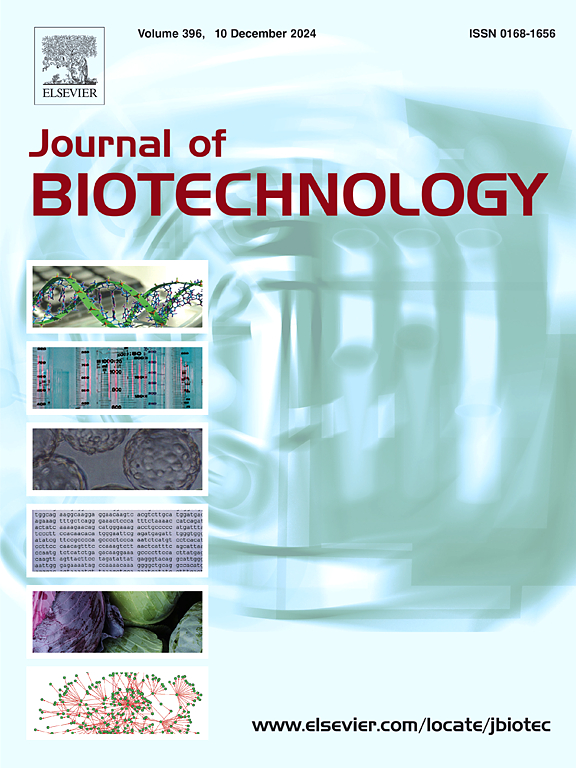Enhanced accumulation of important bioproducts in Chlorella vulgaris through AGPase gene silencing coupled with polyethylene glycol treatment
IF 4.1
2区 生物学
Q2 BIOTECHNOLOGY & APPLIED MICROBIOLOGY
引用次数: 0
Abstract
Microalgae with rapid growth rate, ability to be cultivated in non-agricultural land, and producing numerous bioactive compounds have attracted attention for biofuel production and extraction of valuable co-products. This work focuses on the development of an industrially viable Chlorella vulgaris strain more suitable for biorefinery by downregulating the ADP-glucose pyrophosphorylase (AGPase) enzyme involved in starch biosynthesis. Transgenic lines of C. vulgaris generated through RNA interference (RNAi) demonstrated diminished starch content with an average of 6.7 % (dry cell weight, DCW) from 10 % (DCW) in the untransformed control, after 5 days of shake flask culture in tris acetate phosphate medium with 16 h:8 h light:dark cycle. Under the same growth condition, the total carbohydrate content decreased by an average of 23.5 %, while the lipid content and carotenoid level improved by an average of 19.3 % and 23 %, respectively, in the RNAi lines compared to the control. RNAi lines showed a higher yield of other important co-products, like protein and exopolysaccharide by an average of 30.6 % and 19.6 %, respectively, compared to the control. Interestingly, when polyethylene glycol (PEG) 6000 (0.5 % w/v) was supplemented in the culture medium of C. vulgaris grown till mid-log phase, RNAi lines along with the untransformed control exhibited enhanced level of valuable metabolites after 7 days of PEG treatment. The average carotenoid content of 25.5 μg/mg was recorded in PEG-treated RNAi lines compared to 15.34 μg/mg in PEG-untreated untransformed control alga. Under the similar growth condition, the average lipid content increased to 22.5 % (DCW) in PEG-treated RNAi lines compared to 16.28 % (DCW) in PEG-untreated untransformed control. Overall, the study encompasses use of genetic engineering tool in combination with the application of biochemical modulator PEG to divert the carbon flux from starch biosynthesis towards improved production of important metabolites in microalga.
通过 AGPase 基因沉默和聚乙二醇处理,增强小球藻中重要生物产品的积累
微藻类具有生长速度快、可在非农用地栽培、能产生多种生物活性化合物等特点,在生物燃料生产和提取有价值的副产品方面备受关注。这项工作的重点是通过下调参与淀粉生物合成的 ADP-葡萄糖焦磷酸化酶(AGP 酶),开发更适合生物精炼的工业化小球藻菌株。通过 RNA 干扰(RNAi)产生的转基因粗杆藻品系在 16 h:8 h 光暗循环的磷酸三醋酸酯培养基中摇瓶培养 5 天后,淀粉含量从未转化对照的 10 %(干细胞重量,DCW)降低到平均 6.7 %(干细胞重量,DCW)。在相同的生长条件下,与对照组相比,RNAi 株系的总碳水化合物含量平均降低了 23.5%,而脂质含量和类胡萝卜素含量则分别平均提高了 19.3% 和 23%。与对照相比,RNAi 株系的其他重要副产品(如蛋白质和外多糖)的产量平均分别提高了 30.6% 和 19.6%。有趣的是,当聚乙二醇(PEG)6000(0.5 % w/v)被添加到粗壮褐藻的培养基中直至菌龄中期时,经 PEG 处理 7 天后,RNAi 株系和未转化的对照表现出更高的有价值代谢物水平。经 PEG 处理的 RNAi 株平均类胡萝卜素含量为 25.5 微克/毫克,而未经 PEG 处理的未转化对照藻类的类胡萝卜素含量为 15.34 微克/毫克。在相似的生长条件下,PEG 处理的 RNAi 株系的平均脂质含量增至 22.5%(DCW),而 PEG 未处理的未转化对照的平均脂质含量为 16.28%(DCW)。总之,该研究包括利用基因工程工具,结合生化调节剂 PEG 的应用,将碳通量从淀粉生物合成转向提高微藻重要代谢物的产量。
本文章由计算机程序翻译,如有差异,请以英文原文为准。
求助全文
约1分钟内获得全文
求助全文
来源期刊

Journal of biotechnology
工程技术-生物工程与应用微生物
CiteScore
8.90
自引率
2.40%
发文量
190
审稿时长
45 days
期刊介绍:
The Journal of Biotechnology has an open access mirror journal, the Journal of Biotechnology: X, sharing the same aims and scope, editorial team, submission system and rigorous peer review.
The Journal provides a medium for the rapid publication of both full-length articles and short communications on novel and innovative aspects of biotechnology. The Journal will accept papers ranging from genetic or molecular biological positions to those covering biochemical, chemical or bioprocess engineering aspects as well as computer application of new software concepts, provided that in each case the material is directly relevant to biotechnological systems. Papers presenting information of a multidisciplinary nature that would not be suitable for publication in a journal devoted to a single discipline, are particularly welcome.
 求助内容:
求助内容: 应助结果提醒方式:
应助结果提醒方式:


